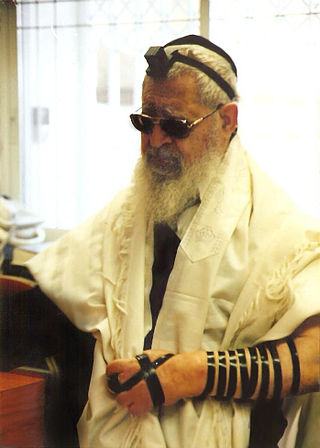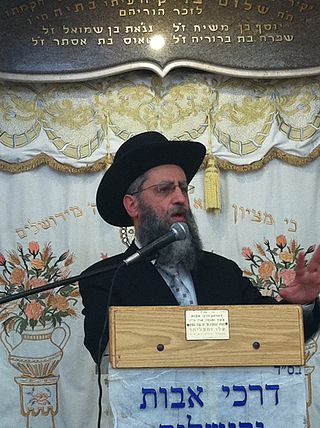Related Research Articles

Sephardic law and customs are the law and customs of Judaism which are practiced by Sephardim or Sephardic Jews ; the descendants of the historic Jewish community of the Iberian Peninsula, what is now Spain and Portugal. Many definitions of "Sephardic" also include Mizrahi Jews, most of whom follow the same traditions of worship as those which are followed by Sephardic Jews. The Sephardi Rite is not a denomination nor is it a movement like Orthodox Judaism, Reform Judaism, and other Ashkenazi Rite worship traditions. Thus, Sephardim comprise a community with distinct cultural, juridical and philosophical traditions.

A kippah, yarmulke, yamaka, bullcap, or koppel is a brimless cap, usually made of cloth, traditionally worn by Jewish males to fulfill the customary requirement that the head be covered. It is worn by all men in Orthodox Jewish communities during prayers and by most Orthodox Jewish men at all other times. Among non-Orthodox Jewish communities, some who wear them do so at all times, while others wear them only during prayer, while attending a synagogue, or in other ceremonies.

Ovadia Yosef was an Iraqi-born Talmudic scholar, a posek, the Sephardi Chief Rabbi of Israel from 1973 to 1983, and a founder and long-time spiritual leader of Israel's ultra-Orthodox Shas party. Yosef's responsa were highly regarded within Haredi circles, particularly among Mizrahi communities, among whom he was regarded as "the most important living halakhic authority".

Shlomo Moshe Amar is the former Sephardic Chief Rabbi of Israel. He served in the position of Rishon LeZion from 2003 to 2013; his Ashkenazi counterpart during his tenure was Yona Metzger. In 2014 he became the Sephardic Chief Rabbi of Jerusalem.
Minhag is an accepted tradition or group of traditions in Judaism. A related concept, Nusach (נוסח), refers to the traditional order and form of the prayers.
In Judaism, Nusach is the exact text of a prayer service; sometimes the English word "rite" is used to refer to the same thing. Nusakh means "formulate" or "wording".

Har HaMenuchot is the largest cemetery in Jerusalem. The hilltop burial ground lies at the western edge of the city adjacent to the neighborhood of Givat Shaul, with commanding views of Mevaseret Zion to the north, Motza to the west, and Har Nof to the south. Opened in 1951 on 300 dunams of land, it has continually expanded into new sections on the northern and western slopes of the hill. As of 2008, the cemetery encompasses 580 dunams in which over 150,000 people are buried.
Howard (Chaim) Jachter is an American Orthodox rabbi, Dayan, educator, and author. He sits on the Beth Din of Elizabeth, New Jersey as a Dayan and Get administrator. Noted as an expert on the laws of Jewish divorce, he also chairs the Agunah Prevention and Resolution Committee of the Rabbinical Council of America. Rabbi Jachter is also the consulting rabbi for over 60 Eruvs across the United States. He serves as the Rabbi of Sha'arei Orah, the Sephardic Congregation of Teaneck, and is a faculty member at the Torah Academy of Bergen County (TABC). Author of sixteen books and over one thousand online and journal articles, he writes and lectures extensively on contemporary topics in Jewish law and thought. He has five children.
Abraham Hecht was a Chabad-affiliated American Orthodox rabbi, and president of the Rabbinical Alliance of America – Igud HaRabanim. Known as a "rabbi's rabbi" and a scholar of Torah, Hecht was regarded by some as one of America's most articulate Orthodox rabbinic leaders.
Nusach Sefard, Nusach Sepharad, or Nusach Sfard is the name for various forms of the Jewish siddurim, designed to reconcile Ashkenazi customs with the kabbalistic customs of Isaac Luria. To this end it has incorporated the wording of Nusach Edot haMizrach, the prayer book of Sephardi Jews, into certain prayers. Nusach Sefard is used nearly universally by Hasidim, as well as by some other Ashkenazi Jews but has not gained significant acceptance by Sephardi Jews. Some Hasidic dynasties use their own version of the Nusach Sefard siddur, sometimes with notable divergence between different versions.

Mishpacha- Jewish Family Weekly is a Haredi weekly magazine package produced by The Mishpacha Group in both English and Hebrew.
Vien is an American Haredi Kehilla (community) originating in present-day Vienna. The name of their congregation is "Kehal Adas Yereim Vien".
Nusach Ashkenaz is a style of Jewish liturgy conducted by Ashkenazi Jews. It is primarily a way to order and include prayers, and differs from Nusach Sefard and Baladi-rite prayer, and still more from the Sephardic rite proper, in the placement and presence of certain prayers.
In Jewish law, a posek is a legal scholar who determines the application of halakha, the Jewish religious laws derived from the written and Oral Torah in cases of Jewish law where previous authorities are inconclusive, or in those situations where no clear halakhic precedent exists.

Sephardic Haredim are Jews of Sephardi and Mizrahi descent who are adherents of Haredi Judaism. Sephardic Haredim today constitute a significant stream of Haredi Judaism, alongside the Hasidim and Lita'im. An overwhelming majority of Sephardic Haredim reside in Israel, where Sephardic Haredi Judaism emerged and developed. Although there is a lack of consistency in many of the statistics regarding Haredim in Israel, it is thought that some 20% of Israel's Haredi population are Sephardic Haredim. This figure is disputed by Shas, which claims that the proportion is "much higher than 20%", and cites voting patterns in Haredi cities to support its position.
Baruch Ben Haim was a Sephardi Hakham who served as Chief Rabbi of the Syrian Jewish community in Brooklyn, New York for 55 years. He taught at Magen David Yeshiva and established the Shaare Zion Torah Center at Congregation Shaare Zion. He was a protege of Rabbi Ezra Attiya, rosh yeshiva of Porat Yosef Yeshiva, who trained and dispatched students to leadership positions in Sephardi communities around the world.

David Yosef is an Israeli rabbi who has authored dozens of books in Jewish Law mainly based on the rulings of his father, Rabbi Ovadia Yosef. His most notable work is a set of books named Halacha Berura, which is an encyclopedia like commentary on the Shulchan Aruch, with letters of approbation from his father and Rav Yosef Shalom Elyashiv.
RabbiYosef Haim HaCohen was the President of the Ma’araviim Community in Jerusalem, as well as the rabbi, dayan, shadar and rabad of the congregation.
Zvi Aryeh Benzion Rosenfeld was an American rabbi and educator credited with introducing Breslov Hasidism to the United States. Teaching children, teens, and adults in New York City for nearly three decades, he inspired a large percentage of his students from non-religious and Modern Orthodox homes to become Hasidic, and also acquainted them with the teachings of the 19th-century Hasidic master Rebbe Nachman of Breslov. He led the first official group of American Breslovers to Rebbe Nachman's grave in Uman, Ukraine, in 1963, and arranged for the first English translation of two key Breslov texts, Shivchei HaRan and Sichot HaRan. He was also an active supporter of the Breslov community in Israel, raising charity funds on behalf of needy families and the majority of funds for the construction of the Breslov Yeshiva in the Mea Shearim neighborhood of Jerusalem.

Eli J. Mansour is a rabbi at Edmond J. Safra Synagogue in Brooklyn.
References
- ↑ Arnold Dashefsky; Ira M. Sheskin (2017). American Jewish Year Book 2016.
- ↑ "NYPD Increases Patrols Around Brooklyn Synagogues". The Jewish Press. March 10, 2015.
- ↑ "The link to every Jewish link". Intermountain Jewish News (JewishLink.net). Retrieved July 12, 2020.
- ↑ Colin Campbell (February 28, 2012). "Sephardic Magazine Goes All Out for Storobin". The New York Observer.
- ↑ "Rabbi Eli J. Mansour to Speak at Benaroya Sephardic Center". JewishLink (Bergen). September 13, 2018.
- ↑ "... It is proper for a Sephardic Jew praying in an Ashkenazic minyan to stand for Kaddish and Barechu (Rav David Yosef, Halachah Berurah (56:17)." Rav David Yosef. "standing when praying with an Ashkenaz congregation". Archived from the original on 2017-09-26. Retrieved 2020-07-13.
- ↑ Yehuda Azoulay (April 2010). "From Italy to Jerusalem". Community Magazine. Brooklyn. Archived from the original on 2 February 2017. Retrieved 24 January 2017.
- ↑ Mezuza .. "on the door post near his bunk bed" on the International Space Station."Jews in Space". Community Magazine (Brooklyn). March 2017. p. 44. REPRINT: https://www.queensjewishlink.com/index.php/style-living/11-news/israel/443-jewish-astronauts-reach-for-the-heights(originally posted: http://www.communitym.com/article.asp?article_id=104383&article_type=0%5B%5D)
- ↑ the color green is an additive primary color. "Primary colors". April 2013.[ dead link ]